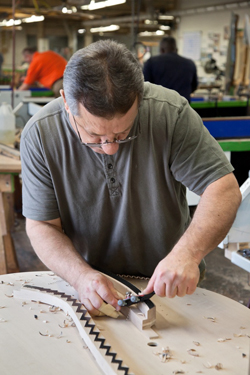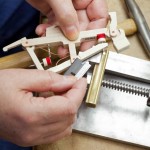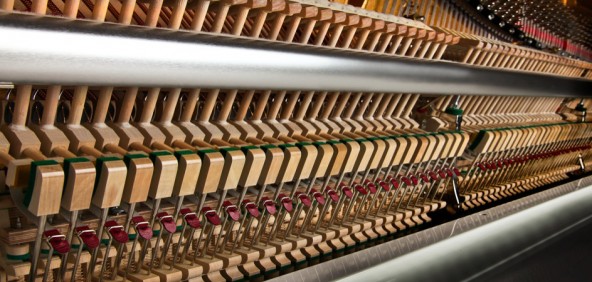If you are looking for a piano that will inspire, it is important to know that the instrument was built to last. Today, it is easy to find a quality piano in your price range if you know a few simple things to look for.
The most reliable way to judge the quality and craftsmanship of any piano is to take a look at the materials the builder used.

“When you’re a carpenter making a beautiful chest of drawers, you’re not going to use a piece of plywood on the back, even though it faces the wall and nobody will see it. You’ll know it’s there, so you’re going to use a beautiful piece of wood on the back. For you to sleep well at night, the aesthetic, the quality, has to be carried all the way through.” — Steve Jobs
Quality woods
Today, woodworking skills refined over thousands of years are still handed down through apprenticeships. In our age of synthetics and disposable goods, fine products made from wood still stand as the mark of unparalleled craftsmanship and speak of a continuously evolving tradition.
In an instrument with over 12,000 parts, the quality can only be as good as its weakest link. Simply put, the use of wood in a piano tells us that the piano was built with skill.
Start here

Natural wood action parts are built by hand to tolerances of 1/1000th of an inch.
The piano action- either in an upright or a grand – really tells us a lot. Making these small, intricate parts demands precision and an eye for detail. The best piano builders only put the best actions in their pianos because, well, it makes sense. A piano is only as good as its lowest quality component.
Look inside every piano. Really look inside. If you’re at a piano store, ask them to remove the top board on an upright or to “pull the action” on a grand piano. It’s easy for a professional to do. If you’re looking at a piano someone is selling privately, have a qualified piano technician do this for you.

Upright Piano Action with quality wood parts.
What you want to see is this beautiful assembly of natural wood, felt, and metal pieces. This time tested design tells you that the builder set out to produce a quality acoustic piano. If you see synthetic parts, it is safe to assume that the piano was built to a lower quality standard.
While you’re looking at the action, it is easy to see the keys.

Placing key weights based on the properties of each natural wood key.
Because a piano’s keys are each a different length and each of the hammers are a different size, the keys need a little help to create an even feel from note to note. This is done by using weights installed through the sides of the key sticks.
The effort put in placing weights in exactly the right spot (get a picture) pays off in a much better feel and is another indication of the builder’s skill. Simply seeing these weights in the keys tells us that the piano was built with quality and designed to last.
Where to look next

Soundboards are built by combining planks of close grain spruce.
Once we see organic materials like wood, felt, and steel in the action, it is time to move on to the soundboard. The soundboard is the single most important part of the piano because it’s what you actually hear when the piano is played. You can see the soundboard by looking at the back of an upright or at an opened grand piano.
Over the years soundboards have been made of many types of wood. The best, most stable soundboards are made from spruce. Spruce is a strong, light wood, prized for its ability to carry sound, with a distinctive grain that runs in straight, parallel lines.
This grain will tell you a lot about how well the piano was built. Wood from a home improvement store is fine for the casual woodworker. A piano designed to last for half a century or more demands higher quality materials, but, it only makes sense to use those materials if the craftsman has the skills to use them properly. That’s why we can learn a lot about how well a piano was built by the quality of the wood.
Simply put, the tighter the grain, the better the wood, and better the piano was built. When we come across young pianos (less than 30 years old) with loose tuning pins and other major problems they overwhelmingly have low quality soundboards.
While we’re looking at the soundboard, you should notice the ribs running across the back (upright) or bottom (grand). These ribs have the very important job of maintain the crown of the soundboard.

Pre-crowned ribs are attached to a close-grain spruce soundboard.
To get the soundboard to “sing,” it is installed in the piano curved, with its crown arching toward the strings. All string instruments – including violins and cellos – work this way. The trick is, when you bend a piece of wood like this, it always wants to go back to its original shape… flat.
Gluing ribs that are “precrowned” – that is, cut with the curve we want the soundboard to maintain – works well. The best builders display their talents by taking this a step further.
By cutting precision dado cuts around the perimeter of the frame (upright) or rim (grand) and installing ribs that extend beyond the edge, the soundboard crown becomes “locked in,” with the frame adding additional support.
Now the pieces really begin to fit together. A builder would only use longer ribs if they can manage a dado cut. They would only attempt dado cuts if they are using a high quality soundboard. They would only use a high quality soundboard if they built a natural wood action. That’s how the total becomes greater than the sum of the parts.
Find a piano made from quality natural materials and built by experienced craftsman and you will have an instrument that sounds beautiful and will last for generations. Of course, it always helps to know an expert!
Because these are the marks of craftsmanship, every one of our new pianos – and most of our used pianos – have all of these important features. We also use these criteria in determining our used piano prices.
Congratulations! You’re ready to visit Steinway Piano Gallery to find your perfect piano…